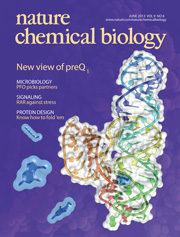
Crystal structure of the preQ1-II riboswitch.
The preQ1-II riboswitch structure reveals the chemical details of preQ1 binding in a pocket formed at the junction of three RNA helices. Complementary work from Wedekind's lab showed that preQ1 promotes a more compact shape that leads to blocking of a signal that is necessary for protein synthesis, which leads to lower levels of preQ1 in the cell. Of special note was the lab's observation that the mechanism of action used by the preQ1-II RNA riboswitch is entirely different than that used by the class I preQ1 riboswitch, whose structure and mode of preQ1 binding were reported previously by Wedekind's lab. Overall the results expand the known repertoire of metabolite-binding modes used by regulatory RNAs.